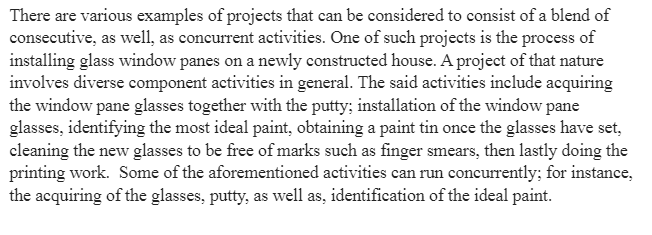Project Management Tools-To receive full credit for discussion participation, you should post a message during the first three days of the module. The Week 1 topic requires nothing more than some thought and reflection, while the Week 2 topic requires specific knowledge of the module’s contents. For full credit, you should respond to both topics. We suggest you do the Week 1 topic first, but please feel free to respond to either topic, at any time.
Week 1 Topic: “How long will this take?”
Some projects have specific activities that need to be completed consecutively; that is, or one after another. One example of this is baking a cake. You can’t put the cake tin into the oven until you’ve filled it with cake batter. You can’t put the batter into the tin until you’ve greased the tin. The batter isn’t ready until you’ve sifted flour into a bowl, added eggs, added baking powder, etc.
Other projects have activities that can be completed concurrently, or at the same time. One example is detailing a car. One guy can vacuum the interior while another applies Armor-All to the wheels, and yet another waxes the exterior. (Even this project has some consecutive activities. For example, a worker can’t apply Armor-All to the interior until somebody’s vacuumed the interior, and wiped everything down.)
Most of us are familiar with projects consisting only of consecutive activities. Such a project may be long and involved, but conceptually it’s simple—just do one thing after another. Other projects consists only of concurrent activities; all the different parts of the project can be worked on at the same time, and when they’re all done, the project is done. Still other projects consist of a mix of consecutive and concurrent activities. For your first posting, try to give an example of such a project.
Looking ahead: PERT-CPM gives us a tool for predicting how long projects consisting of both consecutive and concurrent tasks are going to take, and how much they’re going to cost.
Week 2 Topic: When will PERT-CPM work?
PERT-CPM, like the other tools considered thus far, is not a “Swiss Army knife.” It won’t solve all problems. Its usefulness is limited by the nature of the project, and the state of the manager’s knowledge about what the project will involve.
Here are some questions that need to be answered before deciding whether to use PERT-CPM. The list is far from exhaustive.
- To what extent can the project be broken down into discrete tasks? How should that breakdown happen? Example: When building a house, is tiling the floors and the shower stalls one job, or two?
- To what extent are the tasks sequentially dependent? Example: Again, when building a house, the kitchen exhaust fan should be installed before the attic is insulated; but if need be, the insulation can be swept aside and the fan installed later.
- How accurately are the task durations known?
- How accurately are the task costs known?
- Are the start date and the deadline “set in stone,” or merely aspirational? (“It would be nice if we could move in before Christmas, but… well, you know, whatever.”)
Discussion General Expectations
- In your first posting, you should show a basic understanding of the issues involved in the module. In your second and subsequent postings, you should demonstrate a clear understanding of the material covered in the module.
- Critically apply your understanding to the examples provided by others. Do those examples clearly illustrate the concepts being discussed? Why or why not?
- Provide relevant sources for any information that isn’t common knowledge.
Answer Preview-Project Management Tools

